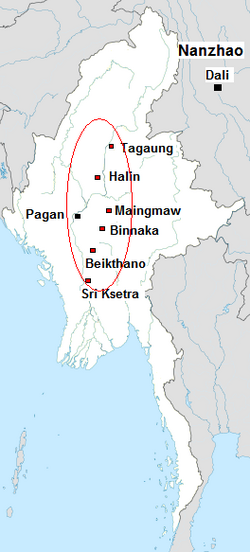Sri Ksetra Kingdom
| Kingdom of Sri Ksetra | ||||||||
| သရေခေတ္တရာ | ||||||||
|
||||||||
| Capital | Sri Ksetra | |||||||
| Languages | Pyu | |||||||
| Religion | Buddhism, animism, Vaishnavism | |||||||
| Government | Monarchy | |||||||
| Historical era | Classical Antiquity | |||||||
| • | Founding of Kingdom | c. 3rd to 9th century CE | ||||||
| • | Launch of Burmese calendar | 21 March 640 | ||||||
| • | Duttabaung ascends to throne | 25 March 739 | ||||||
| • | Fall of Kingdom | c. 1050s | ||||||
|
||||||||
Sri Ksetra (သရေခေတ္တရာ ပြည်, IPA: [θəjè kʰɪʔtəjà pjì]; lit. "Field of Fortune" or "Field of Glory"), located along the Irrawaddy River at present-day Hmawza, was once a prominent Pyu settlement. The Pyu occupied several sites across Upper Myanmar, with Sri Ksetra recorded as the largest, the city wall enclosing an area of 1,477 hectares. Issues surrounding the dating of this site has meant the majority of material is dated between the seventh and ninth centuries AD, however recent scholarship suggests Pyu culture at Sri Ksetra was active centuries before this.
Sri Ksetra is the site for much of the Pyu artistic legacy. The arrival of Buddhism into the Pyu cities saw the increased artistic production, with very little surviving from the earlier period of occupation. The vast arraying of surviving material indicates a rich visual culture that was endorsed by the Pyu at Sri Ksetra.
The Pyu at Sri Ksetra declined in prominence around the ninth century AD. The final mention of the Pyu is found at Pagan, with a twelfth century stone featuring inscriptions in Pyu, Mon, Burmese and Pali.
Burmese legends greatly differ from the reconstruction of Pyu history by scholars. A widely held belief, based on the interpretation of the extensive interdisciplinary evidence suggests that Sri Ksetra was founded between the fifth and seventh centuries by the Pyu people. This interpretation has been challenge by scholars who have argued that it was occupied earlier then these dates. Radiocarbon dating tested on charcoal found at Sri Ksetra produce dates to between 50 – 200 AD, a timeframe that is significantly earlier then previously considered. This early date in the first centuries of the first millennium AD would place the Pyu as one of the earliest urbanised people in Southeast Asia.
Sri Ksetra is the largest Pyu site discovered thus far (Beikthano and Sri Ksetra are the only Pyu sites that have been extensively excavated. Other important Pyu cities as Maingmaw and Binnaka could yield more artefacts with more extensive excavations). It occupied an area larger than that of the eleventh century Pagan or nineteenth century Mandalay. The city walls at Sri Ksetra are the largest of any Pyu settlements. Numerous ruined stupas and temples have been discovered both inside and outside the city walls at Sri Ksetra. The three principal stupas that are a feature of the Pyu landscape at Hmawza, Bawbaw gyi, Payama and Paya gyi, are also located outside the walls.
In conjunction to archaeological evidence, there are a number of written records that mention the Pyu, largely found in Chinese historical accounts. The earliest mention is the fourth century AD account by Ch'ang Ch'u, with later accounts by Chinese pilgrims Xuanzang and Yijing in the seventh century AD . In the eighth century AD Tang histories mentioned the arrival at the court of an embassy from the Pyu capital in 801. While these written records assist with the dating of Sri Ksetra and demonstrate cross-cultural interactions, they are fragmented and cannot all be backed by other evidence.
...
Wikipedia

